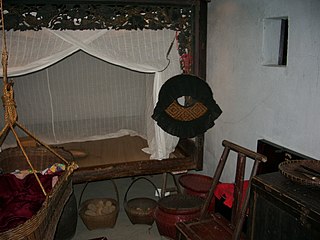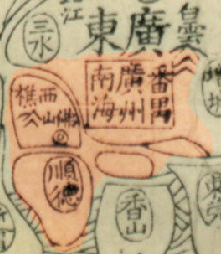
Cantonese or Yue cuisine is the cuisine of Guangdong province of China, particularly the provincial capital Guangzhou, and the surrounding regions in the Pearl River Delta including Hong Kong and Macau. Strictly speaking, Cantonese cuisine is the cuisine of Guangzhou or of Cantonese speakers, but it often includes the cooking styles of all the speakers of Yue Chinese languages in Guangdong. Scholars categorize Guangdong cuisine into three major groups based on the region's dialect: Cantonese, Hakka and Chaozhou cuisines. On the other hand, the Teochew cuisine and Hakka cuisine of Guangdong are considered their own styles, as is neighboring Guangxi's cuisine despite eastern Guangxi being considered culturally Cantonese due to the presence of ethnic Zhuang influences in the rest of the province. Cantonese cuisine is one of the Eight Culinary Traditions of Chinese cuisine. Its prominence outside China is due to the large number of Cantonese emigrants. Chefs trained in Cantonese cuisine are highly sought after throughout China. Until the late 20th century, most Chinese restaurants in the West served largely Cantonese dishes.

Guangdong, alternatively romanized as Canton Province or Kwangtung, is a coastal province in South China on the north shore of the South China Sea. The capital of the province is Guangzhou. With a population of 126.01 million across a total area of about 179,800 km2 (69,400 sq mi), Guangdong is the most populous province of China and the 15th-largest by area as well as the second-most populous country subdivision in the world. Its economy is larger than that of any other province in the nation and the third largest sub-national economy in the world with a GDP of 1.95 trillion USD in 2021. The Pearl River Delta Economic Zone, a Chinese megalopolis, is a core for high technology, manufacturing and foreign trade. Located in this zone are two of the four top Chinese cities and the top two Chinese prefecture-level cities by GDP; Guangzhou, the capital of the province, and Shenzhen, the first special economic zone in the country. These two are among the most populous and important cities in China, and have now become two of the world's most populous megacities.

Yue is a group of similar Sinitic languages spoken in Southern China, particularly in Liangguang.

Cantonese is a language within the Chinese (Sinitic) branch of the Sino-Tibetan languages originating from the city of Guangzhou and its surrounding area in Southeastern China. It is the traditional prestige variety of the Yue Chinese dialect group, which has over 80 million native speakers. While the term Cantonese specifically refers to the prestige variety, it is often used to refer to the entire Yue subgroup of Chinese, including related but largely mutually unintelligible languages and dialects such as Taishanese.
The subgroups of the Han Chinese people, Chinese dialect groups or just dialect groups, are defined based on linguistic, cultural, ethnic, genetic and regional features. The terminology used in Mandarin to describe the groups is: "minxi", used in Mainland China or "zuqun", used in Taiwan. No Han subgroup is recognized as one of People's Republic of China's 56 official minority ethnic groups. Scholars like James W. Hayes have described the Han Chinese subgroups as "ethnic groups" outright, at least in the context of Hong Kong society.

The egg tart is a kind of custard tart found in Chinese cuisine derived from the English custard tart and Portuguese pastel de nata. The dish consists of an outer pastry crust filled with egg custard. Egg tarts are often served at dim sum restaurants and cha chaan tengs.

Punti is a Cantonese endonym referring to the native Cantonese people of Guangdong and Guangxi. Punti designates Weitou dialect-speaking locals in contrast to other Yue Chinese speakers and others such as Taishanese people, Hoklo people, Hakka people, and ethnic minorities such as the Zhuang people of Guangxi and the boat-dwelling Tanka people, who are both descendants of the Baiyue – although the Tanka have largely assimilated into Han Chinese culture.

The Cantonese people, or Yue people, are a Yue-speaking Han Chinese subgroup originating from or residing in the provinces of Guangdong and Guangxi, in Southern Mainland China. Although more accurately, "Cantonese" refers only to the people from Guangzhou and its satellite cities and towns and/or native speakers of Standard Cantonese, rather than simply and generally referring to the people of the Liangguang region.
The Weitou dialect is a dialect of Yue Chinese. It forms part of the Guan–Bao branch of Yuehai. It is spoken by older generations in Luohu and Futian districts in Shenzhen, and by those in the New Territories, Hong Kong.

Cantonese people represent the largest group in Hong Kong. The definition usually includes people whose ancestral homes are in Yue Chinese speaking regions of Guangdong province, specifically the guangfu (廣府) region, although sometimes Sze Yap people, the Hakka people or Teochew people may be included. Historic Hong Kong censuses distinguished people of Guangdong origin into Guangzhou and Macau, Sze Yap (Siyi), Chaozhou, and Hainan origins, as well as the Indigenous people of the New Territories.

Hong Kong Cantonese is a dialect of the Cantonese language of the Sino-Tibetan family. It is the native and de facto standard language of Hong Kong, one of the two special administrative regions of the People's Republic of China. A similar dialect is also spoken in Macau.

TVS Television, originally known as Southern Television Guangdong is a regional Chinese language sub-network under Guangdong Radio and Television in Southern China. TVS is based in Guangzhou and covers mainly in Guangdong and Hong Kong. Most of the channels programming and broadcast is mainly in Cantonese, with additional Mandarin Chinese broadcasts.

Huadu District is one of 11 urban districts of the prefecture-level city of Guangzhou, the capital of Guangdong, China. It is located in the far northern suburbs of the city.
Sze Yap Cantonese represents the second largest Han group in Hong Kong after the group of people (Punti) originating from the Guangzhou-Sam Yap region. The Sze Yap Cantonese comes from a region in Guangdong in China called Sze Yap, now called Ng Yap, which consists of the counties of Taishan, Kaiping, Xinhui, Enping, Heshan and Jiangmen. The Sze Yap Cantonese group have contributed much to what makes Hong Kong a success. Hong Kong people of Sze Yap origin represented about 18.3% of Hong Kong's total population in 1961, and 17.4% in 1971; today this population still increases as more immigrants from the Taishanese-speaking areas of Guangdong in mainland China continue to immigrate to Hong Kong.
In July 2010, the Chinese People's Political Consultative Conference (CPPCC) Guangzhou Committee, in a written proposal to mayor of Guangzhou Wan Qingliang, suggested increasing Mandarin programming on Guangzhou Television's main and news channels. The proposal sparked widespread controversy, met with fierce criticism in native Cantonese-speaking cities including Guangzhou and Hong Kong, which eventually triggered a mass protest in the former city. In a formal response, Guangzhou TV rejected the proposal, citing "historic causes and present demands" as reasons for Cantonese-Mandarin bilingualism.
The Chinese language enjoys the status as official language in Mainland China, Hong Kong, Macau, Singapore and Taiwan, Penghu, Kinmen and Matsu. It is also widely used in Malaysia. However, the language shows a high degree of regional variation among these territories.
Guangzhou is a city in China's Guangdong Province.

Sanyi or Nanpanshun, also known by Cantonese romanizations such as Sam Yup and Nam Pun Shun, refers to the three districts of Nanhai, Panyu and Shunde surrounding Guangzhou and Foshan in Guangdong China.

The Guangdong–Hong Kong–Macau Greater Bay Area also referred as the Greater Bay Area (GBA), is a megalopolis, consisting of nine cities and two special administrative regions in South China. It is envisioned as an integrated economic area aimed at taking a leading role globally by 2035.
Yunfu Cantonese or Yunfu vernacular is a dialect of Yue Chinese spoken in Yunfu, Guangdong, China. It is classified as a variety of Yuehai Yue, or in more recent classification, Guangfu Yue.












